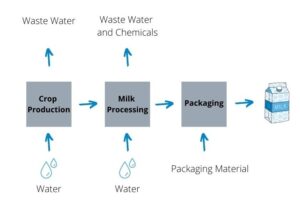A big misconception is that milk is taken directly from a cow and put in a bottle. But this is not entirely true as the process of turning raw milk into consumer milk is much more complicated than that. The process has an enormous environmental impact. In recent years there has been a rise in popularity of plant-based milks because of its taste and health benefits, but are these new substitutes better for the environment? The food sector has the highest consumption of water, and in fact, 86% of all the water in the world is used to grow food. The process of producing each type of milk generates their own water footprint. A water footprint is an indicator of how much water both directly and indirectly is used by a customer or producer. So you and I both have water footprints from eating food, driving our cars, taking showers, and many more things in our daily life. The water footprint for milk is calculated by the total volume of freshwater that is, directly and indirectly, used to produce it. The three main types of milk I am going to talk about will be cow milk, soy milk, and almond milk, and the water waste that is accumulated as part of the production process for these types of milk.
Growing up I always believed like many other people that milk came directly from a cow straight into the container. But that is a huge misconception about the milk industry. In reality, the milk needs to be processed multiple times before it can be packaged and shipped out. Each year the milk industry generates 3.739 to 11.217 million m^3 of water waste. This amount of water is 1 to 3 times the volume of milk that is processed and packaged each year. That means that for every 1L of cow milk 1,050L of water waste is generated. Because of the lack of interest and knowledge in this topic from general people, many do not know the environmental impact that happens because of all the waste. Some of this water waste accumulates during various systems of milk production in the factories, such as cleaning systems, cooling systems, and steam generators. This cleaning system results in the clean water waste mixing with the cleaning solutions that are pumped through the unit. This chemical mixture is still in the water when it is disposed of into the nearby river, land, and fields. This chemical mixture is a highly odorous black sludge that can cause destructive environmental impacts.
Recently there has been a rise in the demand for milk alternatives that provide better health benefits. Because of this, there has also been a rise in many misconceptions about the environmental impact of these alterations. I know when I first learned about alternatives like soy milk and almond milk, I believed that while they had great health benefits they also had positive environmental benefits along with it. While they do have the least water waste with the processing of the milk; other areas of the production process also accumulate water waste. With all three milk substitutes, there is an increase in water waste from the crop production of these products. For soy milk, every 1 L generates 297 L of water waste.
Sadly out of the three milk options I looked at, there truly is no winner when it comes to lessening the environmental impact just based on picking a new milk substitute. In the image, you ca n see the simplified engineering diagram for the production of milk. In two of the stages for all types of milk, water is entering the system for crop production and the processing of milk. While the amount of water that is used for each step is different depending on the milk, there still is an amount of wastewater that exists for each milk type. But there are some ways production companies can adopt to decrease their water waste. One way for almond milk would be to shift the sourcing and production of almonds to locations that have a more efficient irrigation system. For cow milk, research might find a better way to streamline the process and to lessen the amount of chemicals introduced to water waste.
n see the simplified engineering diagram for the production of milk. In two of the stages for all types of milk, water is entering the system for crop production and the processing of milk. While the amount of water that is used for each step is different depending on the milk, there still is an amount of wastewater that exists for each milk type. But there are some ways production companies can adopt to decrease their water waste. One way for almond milk would be to shift the sourcing and production of almonds to locations that have a more efficient irrigation system. For cow milk, research might find a better way to streamline the process and to lessen the amount of chemicals introduced to water waste.
References:
Boguniewicz-Zablocka, J., Klosok-Bazan, I. & Naddeo, V. Water quality and resource management in the dairy industry. Environ Sci Pollut Res 26, 1208–1216 (2019). https://doi.org/10.1007/s11356-017-0608-8
Courtney A. Grant and Andrea L. Hicks.Environmental Engineering Science.Nov 2018.1235-1247.http://doi.org/10.1089/ees.2018.0233
Ercin, A., Aldaya, M., & Hoekstra, A. (2012, February 28). The water footprint of soy milk and soy burger and equivalent animal products. Retrieved October 08, 2020, from https://www.sciencedirect.com/science/article/abs/pii/S1470160X11004110?casa_token=e3EkrZ26r6IAAAAA%3Ad8BXC4T7XhPCDuL0uNN61qzA0XOht6XXqBIRrM1SH7_nN77SA7FbNk8jDSXLtqZUB29NnRasDXU
Tikariha, A. , & Sahu, O. (2014). Study of Characteristics and Treatments of Dairy Industry Waste Water. Journal of Applied & Environmental Microbiology, 2(1), 16-22.

